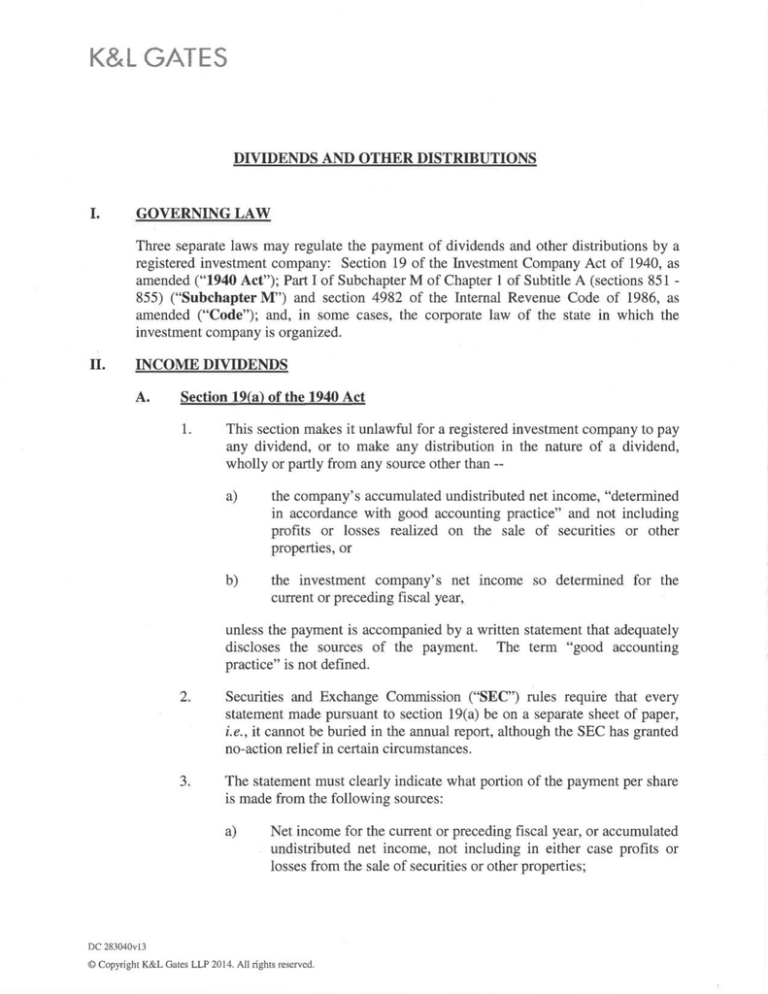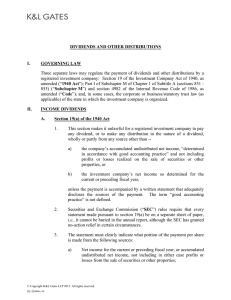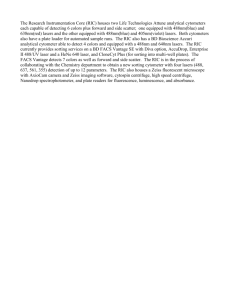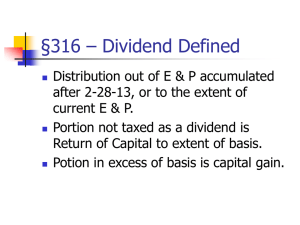
K&L GATES
DIVIDENDS AND OTHER DISTRIBUTIONS
I.
GOVERNING LAW
Three separate laws may regulate the payment of dividends and other distributions by a
registered investment company: Section 19 of the Investment Company Act of 1940, as
amended ( "1940 Act "); Part I of Subchapter M of Chapter 1 of Subtitle A (sections 851 855) ( "Subchapter M ") and section 4982 of the Internal Revenue Code of 1986, as
amended ("Code"); and, in some cases, the corporate law of the state in which the
investment company is organized.
II.
INCOME DIVIDENDS
A.
Section 19(a) of the 1940 Act
1.
This section makes it unlawful for a registered investment company to pay
any dividend, or to make any distribution in the nature of a dividend,
wholly or partly from any source other than -a)
the company's accumulated undistributed net income, "determined
in accordance with good accounting practice" and not including
profits or losses realized on the sale of securities or other
properties, or
b)
the investment company's net income so determined for the
current or preceding fiscal year,
unless the payment is accompanied by a written statement that adequately
discloses the sources of the payment. The term "good accounting
practice" is not defined.
2.
Securities and Exchange Commission ("SEC") rules require that every
statement made pursuant to section 19(a) be on a separate sheet of paper,
i.e., it cannot be buried in the annual report, although the SEC has granted
no-action relief in certain circumstances.
3.
The statement must clearly indicate what portion of the payment per share
is made from the following sources:
a)
Net income for the current or preceding fiscal year, or accumulated
undistributed net income, not including in either case profits or
losses from the sale of securities or other properties;
DC 283040v13
© Copyright K&L Gates LLP 2014. All rights reserved.
K&L Gates LLP
b)
Accumulated undistributed net profits from the sale of securities or
other properties (except that an open-end company may treat as a
separate source its net profits from those sales during its current
fiscal year); or
c)
Paid-in surplus or other capital source.
See Rule 19a-1(a) under the 1940 Act.
4.
B.
On June 13, 2007, the Investment Company Institute submitted to the SEC
recommendations regarding amendments to Rule 19a-1. Among these
recommendations was a proposal to permit investment companies to
satisfy their disclosure obligations under the rule by including the relevant
information on their own, or an affiliate's, Internet web site and in periodic
shareholder communications. The SEC has not yet responded to those
recommendations.
Internal Revenue Code 1
1.
Pass-Through Tax Treatment . Subchapter M provides pass-through tax
treatment to investment companies and series thereof -- each of which is
referred to under the federal tax law as a "regulated investment company"
("RIC") -- that meet certain requirements. 2 They include a requirement
that a RIC's dividends-paid deduction ("DPD") for a taxable year must
equal or exceed the sum of 90% of its investment company taxable income
("ICTI") plus 90% of its net tax-exempt income for the year. A
"preferential dividend" paid by a RIC that is not a "publicly offered
[RIC]" (as defined in the Code) ( "non-publicly offered RIC ") (see
paragraph 4. below) is not eligible for the DPD. Note that a RIC may
qualify for pass-through treatment without having to distribute any
minimum amount of its net capital gain (i.e., the excess of net long-term
capital gain over net short-term capital loss).
2.
Investment Company Taxable Income . ICTI is defined to include net
investment income, the excess of net short-term capital gain over net longterm capital loss, and net gains and losses from certain foreign currency
transactions. ICTI differs from a regular corporation's taxable income
primarily in that it excludes net capital gain and provides a DPD for
For more detail regarding the federal income tax treatment of dividends and other distributions -- as well as the
effect on that treatment that relevant provisions of the "Regulated Investment Company Modernization Act of
2010," enacted on December 22, 2010 ( "RIC Mod Act"), have -- see Federal Tax Aspects at Item 13.
2
More specifically, in determining its own taxable income and net capital gain, a RIC that satisfies the distribution
requirement described in this paragraph may deduct distributions it pays to its shareholders.
bra
Copyright K&L Gates LLP 2014. All rights reserved.
K&L Gates LLP
dividends a RIC pays to its shareholders (excluding, in the case of a nonpublicly offered RIC, preferential dividends).
3.
4.
5.
Exempt-Interest Dividends
a)
If, at the close of each quarter of its taxable year, a RIC holds at
least 50% of its total assets in obligations the interest on which is
excludable from gross income under section 103 of the Code,
dividends it pays to its investors from exempt sources ("exempt interest dividends ") are tax-exempt in their hands as well.
b)
Distributions of exempt-interest dividends may affect
shareholders' capital loss calculations. If a shareholder receives an
exempt-interest dividend from a RIC and redeems or exchanges
some or all of its shares in the RIC within six months after
purchase, any loss on the redeemed or exchanged shares is
disallowed to the extent of the amount of the exempt-interest
dividend received on the shares.
Preferential Dividends
a)
If any part of a distribution by a non-publicly offered RIC is
deemed preferential, the entire distribution fails to qualify for the
DPD. As a result, a non-publicly offered RIC that pays a
preferential dividend is likely to fail to qualify for pass-through tax
treatment under Subchapter M.
b)
Non-publicly offered RICs must take care that programs involving
fee payments or other benefits for some investors and not others
are not considered preferential dividends.
Spillover Dividends
a)
A RIC may in some cases pay a dividend in one taxable year and
count it as having been paid in the preceding taxable year for
purposes of determining its income tax liability for the earlier year.
b)
These so-called "spillover dividends" must be declared by the 15 th
day of the 9th month after the end of the taxable year (or, if later,
the extended due date for filing the RIC's tax return for that year)
to which the dividend is intended to relate; and they must be
distributed within the following taxable year and not later than the
date of the first regular dividend payment made after the
declaration.
-3-
© Copyright K&L Gates LLP 2014. All rights reserved.
K&L Gates LLP
C.
c)
Spillover dividends can apply to ordinary income, capital gain, and
exempt-interest dividends. While they are useful for insuring that
a RIC has complied with the 90% distribution requirement
essential to its status as a pass-through entity, they are not counted
as paid in the preceding calendar year for purposes of determining
the RIC's distributions needed to comply with the 4% excise tax
described below.
d)
For shareholders, spillover dividends are taxable in the year in
which they are actually received.
e)
Although not technically a spillover dividend, a dividend declared
in October, November, or December to shareholders of record in
one of those months, and actually paid in the following January, is
treated by both the RIC and the shareholders as having been paid
on December 31 for all purposes under the Code, including the
excise tax.
Excise Tax
1.
Section 4982 of the Code imposes a nondeductible 4% excise tax on a RIC
unless it distributes by the end of each calendar year at least the sum of
(a) 98% of its ordinary (taxable) income for that year plus (b) 98.2% of its
capital gain net income (both short- and long-term) for the one-year period
ending October 31 of that year plus (c) 100% of any "prior year shortfall."
2.
Note that the measuring period for this tax is not the RIC's taxable (fiscal)
year.
III. CAPITAL GAIN DISTRIBUTIONS
A.
Section 19(b) of the 1940 Act
1.
Section 19(b) and Rule 19b-1 thereunder permit registered investment
companies that qualify for pass-through treatment under the Code (i.e.,
RICs) to declare up to three, and with SEC permission four, capital gain
distributions (as defined below) in a year:
a)
They permit one capital gain distribution of any amount; and the
rule permits a second, supplemental "spillover" distribution with
respect to the same taxable year that does not exceed 10% of the
aggregate amount distributed for that taxable year;
b)
In response to the imposition of the federal excise tax described
above, Rule 19b-1(f) permits investment companies to make one
-4-
© Copyright K&L Gates LLP 2014. All rights reserved.
K&L Gates LLP
additional (third) capital gain distribution with respect to each
taxable year, made in whole or in part for the purpose of not
incurring the excise tax; and
c)
B.
Any investment company that proposes to make an additional
capital gain distribution in a particular taxable year because of
unforeseen circumstances may apply to the SEC for permission.
The request is deemed granted unless the SEC denies it within 15
days after receipt.
Internal Revenue Code
1.
The long-term or short-term character of capital gain a RIC distributes to
its shareholders is determined by how long the RIC held the investment
the sale of which generated the gain, not by how long the shareholder held
the RIC's shares. That character is retained when the RIC distributes the
gain to its shareholders.
2.
Shareholders may treat RIC distributions of net capital gain ( "capital gain
distributions ") as long-term capital gain only if the RIC "reports" the
amount thereof to them. (Before the RIC Mod Act, a RIC was required to
send shareholders a written notice, mailed not more than 60 days after
close of the taxable year, designating the amount of the net capital gain.
Investment companies normally satisfied this notice requirement by
making the required designation in their annual reports to shareholders.)
3.
Capital gain distributions may affect shareholders' capital loss
calculations. If a shareholder receives a capital gain distribution from a
RIC and redeems or exchanges some or all of its shares in the RIC within
six months after purchase, any loss on the redeemed or exchanged shares
is a long-term loss to the extent of the amount of the capital gain
distribution received on the shares.
4.
Also see the discussions of spillover dividends and excise tax at H.B.5.
and II.C., above.
IV. STATE LAW
A.
Corporations
The corporation law of the state in which an investment company is organized
may impose limitations on or procedures regarding distributions.
1.
In Maryland, for example, the Corporations and Associations Article of
the Maryland Code requires that the board of directors authorize any
-5© Copyright K&L Gates LLP 2014. All rights reserved.
K&L Gates LLP
distribution. In addition, no distribution may be made if, as a result, the
corporation would not be able to pay its indebtedness as it becomes due in
the usual course of business. If it is established that a director did not
exercise due care in voting for a dividend, the director may be individually
liable if it appears the corporation cannot pay its debts.
B.
2.
Directors may establish the record date for any distribution. The record
date may not be prior to the close of business on the day the directors fix
the record date.
3.
Additional requirements may be contained in the corporation's charter or
by-laws.
Business/Statutory Trusts
Massachusetts business trusts are largely free of statutory requirements, and many
of the requirements of the Delaware Statutory Trust Act (originally, the Delaware
Business Trust Act) may be overridden by provisions in the trust instrument.
Nevertheless, a trust's declaration of trust (or trust instrument) or by-laws, or
both, may contain restrictions or conditions on the payment of distributions and/or
the establishment of record dates.
S
© Copyright K&L Gates LLP 2014. All rights reserved.








